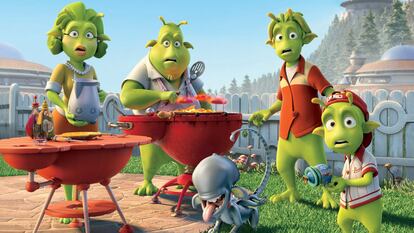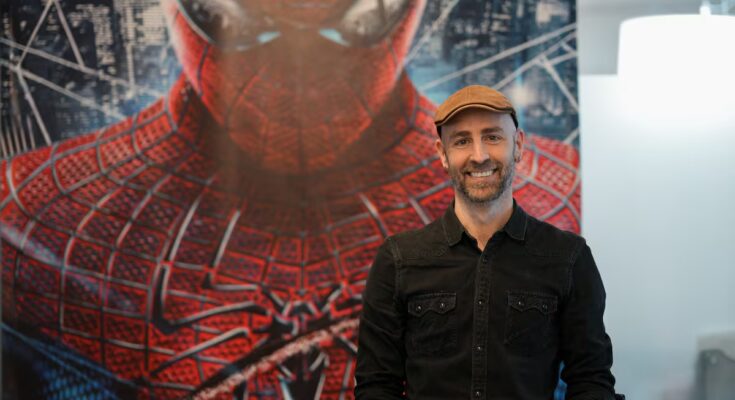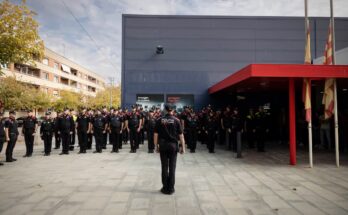Like many parents around the world, Martín Tintxo Esnaola, 43, made a costume for the youngest of her three children at the end of October. The k-pop warriors. The most watched film in the history of Netflix was also the protagonist of this Halloween. Girls, and not so girls, dressed as Rumi, Zoey and Mira, the heroines who crush demons while singing catchy Korean pop songs. But Esnaola’s was not just any costume. He put “lights and everything” to the sword and, above all, in addition to being the father of a fan, this Argentine-born Madrid native worked as an animation supervisor on the Sony superhit.
Esnaola takes the video call in the basement of his home in Vancouver, where he has set up “the whole setup” (five monitors) for when he teleworks. Behind, a printed fabric with The Kanagawa wave It covers washing machines and testifies to his fascination with Japanese aesthetics. He fell in love for his livelihood with Miyazaki’s films at Studio Ghibli (his favorite, Porco Rosso): “With them I understood that animation conveys fantasy and emotion in another way.” Classic anime enthusiast Ghost in the shellthe visual spectacle of Arcane or the raw intimacy of I lost my body, studied animation in Madrid and online “when there were far fewer options for training than there are today,” he says.
His first job was at Real Madrid TV: “I had an ideal schedule and they paid well, but I wanted to entertain.” He worked in Los Angeles, London or Paris, until 2012, when he ended up at Imageworks, Sony Pictures’ animation and special effects studio in Canada. “When I arrived we were a satellite of the Los Angeles office, but we have become the spearhead,” he says of Imageworks, where between 500 and 700 professionals work, but can reach more than a thousand when, as now, it produces up to six or seven projects at the same time: “It’s crazy, but Canada has a lot of incentives and we get out of it cheaply.”
In his CV there are films as diverse as Hotel Transylvania (2012 and 2015), Emojis (2017), Spider-Man: Into the Spider-Verse (2018), The sea monster (2022) or in dreams (2025), which occurred before The k-pop warriors but it will debut, again on Netflix, on November 14th. “When I interview people who want to work here, I explain to them that what I like most is that each film seems to come from a different studio; Disney or Illumination have great quality and great animation, but it gives the impression that they always make the same film. Our style is that we don’t have our own style and this allows you to innovate more.”
With the usual industry secrecy, the sequel to The k-pop warriorsabout which Sony and Netflix are already negotiating, he knows nothing. And also the film he is working on, “an untitled project that has not yet been announced for Netflix”. There he works as animation director (Head of Character Animation). What does the position entail? “In live-action cinema, actors provide the look, voice and performance. In animation, however, there are many people involved in this interpretation. The characters are built in parts: actors who dub the voice, people who design the look, the fitters, those who build the skeleton, the model makers… And finally we get to the animators. Animating comes from soul: we are the ones who give the soul to the characters, we fill them with life.” In that breath of life we decide how the character moves, what gestures he makes, how the character is interpreted… Just like when in a set the traditional cry “Action!” and the magic happens, but in a much longer and tedious process (an animator works on each film for about a year and a half).
The hardest part of his job, says the lead animator, is combining his vision (“what I’d like to do”) with the vision of the directors (“what they want to do”) and the producers (“what can be done”). “There are a lot of meetings, a lot of ideas back and forth, and also a lot of bureaucracy, because every step has to be approved.” All this with budgets reaching 100 million dollars (around 86 million euros) and templates as large as the film credits. Those of The k-pop warriors They last 14 minutes. After a minute and a half “Tintxo Esnaola Scotta” appears along with a version chibi (huge eyes and child-like bodies) of the protagonists. In that first part of the credits “when it’s still fun to stay and watch them because it’s not just a succession of names”, he exults.
With so many people and so many stages, is there the feel of a traditional shoot? “It’s a mix between that and an office job, you share space with people who are making other films, everyone does their own thing, there’s no set…Even if in more passionate projects, like The k-pop warriors, “It generates a strong team feeling,” says Esnaola, who admits that the story created and directed by Maggie Kang (who was, like him, a home entertainer) amazed him from the beginning: “I started watching K-dramas and listening to a lot of K-pop, I wanted to absorb the culture so that everything was very authentic.” He is “very proud” of the result: a film that was born small and was welcomed by the general public and praised by connoisseurs of the genre, precisely for its authenticity.
The scene that seems most appropriate in such a collective work is the Saja Boys’ last musical number. The group of boys, already transformed into demons, sing Your idol in front of a dedicated stadium: “We reinvented part of the choreography and shots, what we received was more traditional and we gave it the push to make it much more dynamic, more K-pop”, explains the entertainer, who has delved into hundreds of video clips looking for movements and attitudes and adapting them so that the animation worked to the rhythm of the music, one of the stylistic keys of the film.

Esnaola, who includes Spanish co-production among his works abroad Planet 51 (2009), doesn’t think he’ll be returning home anytime soon. “That film was the first with which we all thought that the industry would finally take off in Spain!… but it wasn’t entirely like that.” Lately he has received many CVs from Spaniards looking for work, he regrets.
Around the world, another danger lurks in the industry: artificial intelligence. “AND Him The topic right now is the conversation…”, says Esnaola. “We don’t know if it will be a tool that will help us or one that will replace us. The advantage is that the big studios are as afraid as we are, it’s easy for things to get out of hand: they are now the only ones who can make films of a certain level, but if artificial intelligence democratizes production, they run a big risk. They are the first ones interested in controlling it.”



